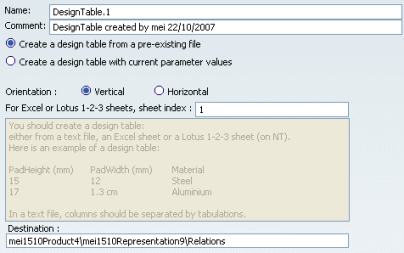About the Design Table Dialog Box | ||||||
|
| |||||
Creation of a Design Table
You can create a Design Table using the Create a design table from a pre-existing file option or the Create a design table with current parameter values option.

Create a design table from a pre-existing file
You can create a Design Table using an already existing file.
Check this option whenever you want to create a design table from the values of an external file. In this case, the created design table is made up of:
- Only the columns whose name is a document parameter name. If the external file contains a "Length" column but no such "Length" parameter is defined in the document, the "Length" column will not appear in the created design table. This is the "automatic" association process.
- Only the columns that have been associated one-by-one with a document parameter. If the external file contains a "Length" column but no so-called parameter in the document, you can choose to associate the "Length" column of the external with a parameter of the same type (a sketch radius for example).
Create a Design Table with Current Parameter Values
You can create a Design Table using the current parameter values.
Check this option whenever you want to create a design table from a subset of the document parameters. Select among all the document parameters the ones you want to be included as columns in the design table. In this case, the created design table only contains a single row.
Orientation
These options allow you to choose the design table orientation. A vertical orientation is recommended when the design table contains many parameters.
- The sheet index lets you specify an Excel or Lotus sheet number.
- The Destination field: All knowledgeware relations such as design tables, rules, checks or formulas, are created by default below the Relations node. Creating a relation below a given feature may help you organize your document. To specify a destination, select the default destination in the Destination field, then click the feature intended to be the new destination either in the specification tree or in the geometry area.
Selection of the Parameters
This dialog box pops up when you select Create a design table with current parameter values.
There are two ways to restrict the list of parameters to be displayed in the Parameters to insert list.
- Filter Name field: Use the * character to specify any string to be included in a parameter name. Specifying *Len* will display in the "Parameters to insert" part of the dialog box all the parameters having the Len substring in their name.
and the Filter Type field.
When you click OK in the dialog box above, the New - Step 1 dialog box is displayed.
Selection of the File to Create
You can use this dialog box to specify the representation. Click the Suffix tab to specify if the associated file is an .xls (Windows) or a .txt file.
| Important: When working in a French environment, make sure that the decimal numbers contained in the text file linked to the design table are not written with a comma "," but with a decimal point. (This way you will be able to move to an English environment easily.) |
Design Table Dialog Box
You can find information concerning the Design Table dialog box.
Configurations Tab
The current configuration and its number (< configuration number >) are highlighted. To change the current configuration, click the new configuration in the design table.
A single row design table is created when you generate a design table with the current parameter values.
- Filter: The filter is a means to help you query for a configuration meeting specific criteria. Click Edit... to display the "Design Table Request Editor".
In a query, you can specify a condition referring to the design table parameters as well as the parameters external to the design table.
- Activity check box: A new design table is active by default. The activity check box provides you with a way to deactivate the design table to be created.
- Edit table...: Click this button to display the edit table to be created. Depending on whether you have selected a .xls extension or not, you will open a Microsoft Excel application or your default text editor for a .txt file.
- Duplicate data in CATIA model: Check this box whenever you intend to reuse your document on an operating system different from the one used to create the design table. That way, your design table data will be duplicated into your document.
Associations Tab
This tab provides you with a way to associate the document parameters with the columns of the external design table. The left part of the dialog box allows you to associate parameters with the design table columns and the right part displays the list of associated parameters.
- Create parameters...: When a parameter is referred to in the design table but has not been created in the document, clicking this button allows you to create a parameter in the document and associate it with the right column of the design table.
- Rename associated parameters: If a parameter does not have the same name as the column it is associated with, you can rename this parameter so that it has the same name as the column. Clicking Rename associated parameters displays a dialog box which asks you whether you want to rename all the parameters or only a few of them.